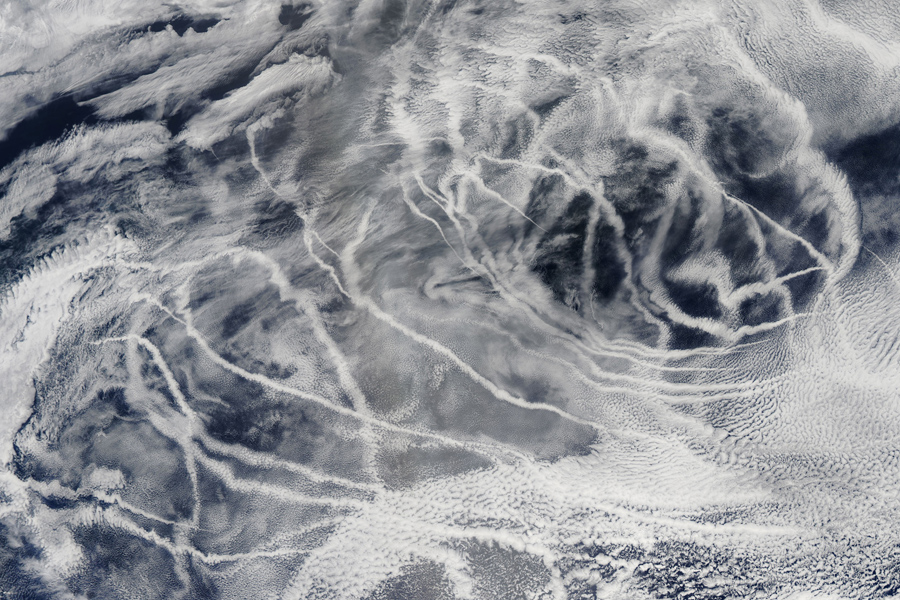
As ships travel across oceans, their emissions interact with the atmosphere to influence clouds in a process that can change how much sunlight they reflect and cool the temperature below wherever they form.

A new study led by Florida State University Assistant Professor Michael Diamond examines how different particles expelled in ship emissions, called aerosols, affect cloud formation and whether technology can harness this phenomenon to help reduce some impacts of climate change.
HOW IT WORKS:
Emissions from ships engaged in worldwide commerce contain microscopic particles of sulfur or carbon. These particles help to create clouds by acting as a platform around which water vapor condenses, forming low-lying, highly reflective clouds known as ships tracks.
In 2020, the United Nations' International Maritime Organization imposed regulations that drastically cut the amount of sulfur in ships' fuel. Reducing the amount of sulfate particles pouring out of smokestacks improved air quality but also had a second, unintended consequence: fewer ship track clouds.
Scientists have long known that pollution particles have a cooling effect on the atmosphere but quantifying that effect and separating it from other things, such as weather patterns or a mix of land-based emissions, was difficult.
Because of their localized changes within a uniform weather pattern, ship tracks offer a natural experiment to understand the effects of different pollution particles on cloud formation.
"The clouds that are forming right next to the ship tracks compared to the clouds that are forming in the ship track are experiencing the same weather state, so any changes we see in the clouds, we can attribute to the pollution itself," Diamond said.
RESEARCH GOALS:
The researchers are comparing clouds formed from sulfur-rich emissions that were common before the 2020 regulation went into effect to the clouds formed from mostly carbon-based pollution that are more common now.
They will answer questions about the aerosols' influence on how often clouds form, how much area they cover and how thick they are.
The research team will use machine learning to analyze thousands of individual ship tracks captured by satellites. Previous efforts relied on manually identifying tracks in satellite images that spanned the globe. They will also use statistical techniques to independently estimate how all the ship tracks together alter long-term average cloud properties over a major shipping lane between Europe and Asia.
"One of the reasons it's so hard for scientists to study this is because relevant things are happening all the way at the nanometer scale and all the way at the scale of thousands of kilometers," Diamond said. "It is difficult to have one consistent framework, either with our computer modeling or with observations that can capture all of that at the same time. Our goal is to combine those methods to get a more comprehensive picture of how different aerosols affect the properties of the clouds they help to create."
The project involves using computer models to extend their findings, investigating what sort of clouds would form if ships were to emit salt particles instead of sulfur or carbon. Spraying salt water into the atmosphere to artificially seed clouds, a proposal called marine cloud brightening, is a potential tool for lowering global temperatures.
WHY IT MATTERS:
The reduction in ship tracks following the 2020 regulations may be behind some of the extreme heat anomalies observed during 2023, especially in regions like the northern Atlantic and Pacific Oceans. Understanding how and why different ship tracks form will help regulators anticipate potential effects from future changes to emissions.
Examining the effects of hypothetical salt sprayers and their potential as a climate engineering tool will help examine if they are a worthwhile investment for reducing some global warming impacts.
WHO'S INVOLVED:
Diamond leads a team that includes researchers from FSU, the Joint Center for Earth Systems Technology at the University of Maryland Baltimore County, NASA, and the company Science Systems and Applications, Inc.
WHERE IS FUNDING COMING FROM:
The National Oceanic and Atmospheric Administration's Climate Program Office is funding the $736,494 project.






